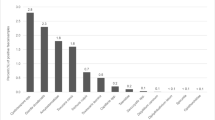Abstract
Using routine coprological methods, 1161 faecal samples from animal shelters located in Madrid (Spain) were analysed, showing a 28% prevalence for different intestinal parasites: Giardia duodenalis (7%), Cystoisopora spp. (3.8%), Toxocara canis (7.8%), Toxascaris leonina (6.3%), Ancylostomidae (4%), Trichuris vulpis (3.3%), Taenidae (2.9%) and Dipylidium caninum (0.9%). The therapeutic efficacies of mebendazole at a dose of 22 mg/kg once daily for 3 days, fenbendazole at a dose of 50 mg/kg once daily for 3 days and a drug combination of febantel–pyrantel–praziquantel at a dose of 15–5–5 mg/kg once were valuated and compared by collecting faecal samples on days 9 and 16 post-treatment from naturally infected dogs in field-trial conditions. From the infected dogs (321 dogs), 150 animals were selected for the study. Distribution randomly divided the animals into three study groups of ten dogs per parasite and per treatment group: group A, mebendazole; group B, fenbendazole and group C, febantel–pyrantel–praziquantel. The therapeutic efficacy against ascarids and ancylostomids (days 9–16) was very high (75–100%) for the three groups: for T. canis, 100% in group A, 80–100% in group B, 97–100% in group C; for T. leonina, 98–100% in group A, 100% in group B, 92–94% in group C and for ancylostomids, 100% in group A, 99–100% in group B, 90–100% in group C. On the other hand, the highest efficacy against Taenidae infections was in group B (90–100%), followed by groups C (73–91%) and A (70–90%).


Similar content being viewed by others
References
Barr SC, Bowman DD, Heller RL (1994) Efficacy of fenbendazole against giardiasis in dogs. Am J Vet Res 55:988–990
Catton DG, Van Schalkwyk PC (2003) The efficacy of two anthelmintics against ascarids and hookworms in naturally infected cats. Parasitol Res 90:144–145
Clark JN, Daorio CP, Plue RE, Wallace DH, Longhofer SL (1992) Efficacy of ivermectine and pyrantel pamoate combined in a chewable formulation against earthworms, hookworms and ascarid infections in dogs. Am J Vet Res 53:517–520
Corba J, Varady M, Tomasovicova O, Stefanko P (1993) Efficacy of fenbendazole in dogs with gastrointestinal nematodes. Veterinarstvi 43:258–259
Corwin RM, Mc Curdy HD, Pratt SE (1982) Effect of febantel against Ancylostoma caninum and Trichuris vulpis infections in dogs. Am J Vet Res 43:1100–1102
Dorchies MF, Ducos de Lahitte J, Berthanneau MC (1980) Traitment du taeniasis du chien et du chat par le praziquantel. Rev Med Vet 131:409–411
Gemmell MA, Johnstone PD, Oudemans G (1977) The effect of praziquantel on Echinococcus granulosus, Taenia hydatigena, and Taenia ovis infections in dogs. Res Vet Sci 23:121–123
Giangaspero A, Traldi G, Paoletti B, Traversa D, Bianciardi P (2002) Efficacy of pyrantel embonate, febantel and praziquantel against Giardia species in naturally infected adult dogs. Vet Rec 150:184–186
Guerrero J, Pancari G, Michael B (1981) Comparative anthelmintic efficacy of two schedules of mebendazole treatment in dogs. Am J Vet Res 42:425–427
Horejs R (1999) Efficacies of different anthelmintics against ascarid infections in young dogs. Veterinarstvi 49:393–396
Katiyar SK, Gordon VR, Mc Laughlin GL, Edlind TD (1994) Antiprotozoal activities of benzimidazoles and correlations with beta tubulin sequence. Antimicrob Agents Chemother 38:2086–2090
Lloyd S, Gemmell MA (1992) Efficacy of a drug combination of praziquantel, pyrantel embonate, and febantel against helminth infections in dogs. Am J Vet Res 53:2272–2273
Mc Kellar QA, Scott EW (1990) The benzimidazole anthelmintics, a review. J Vet Pharmacol Ther 13:223–247
Mehlhorn H, Hanser E, Harder A, Hansen A, Mencke N, Schaper R (2003) Synergistic effects of pyrantel and the febantel metabolite fenbendazole on adult Toxocara canis. Parasitol Res 90:151–153
Morgan UM, Reynoldson JA, Thompson RCA (1993) Activities of several benzimidazoles and tubulin inhibitors against Giardia spp in vitro. Antimicrob Agents Chemother 37:328–331
Nolan TJ, Hawdon JM, Longhofer SL, Daorio CP, Schad GA (1992) Efficacy of an ivermectine/pyrantel pamoate formulation against the canine hookworms, Uncinaria stenocephala and Ancylostoma caninum. Vet Parasitol 41:121–125
Reynoldson JA, Thompson RCA, Horton RJ (1992) Albendazole as a future antigiardial agent. Parasitol Today 8:412–414
Roberson EL, Burke TM (1982) Evaluation of granulated fenbendazole as a treatment for helminth infections in dogs. J Am Vet Med Assoc 180:53–55
Samson-Himmellstjerna GV, Epe C, Schimmel A, Heine J (2003) Larvicidal and persistent efficacy of an imidacloprid and moxidectin topical formulation against endoparasites in cats and dogs. Parasitol Res 90:114–115
Thienpont D, Rochette F, Vanparijs FJ (1979) Diagnostic de verminose par examen coprologique. Janssen, Beerse, pp 35–36
Zajac AM, La Branche TP, Donoghue AR, Chu TC (1998) Efficacy of fenbendazole in the treatment of experimental Giardia infection in dogs. Am J Vet Res 59:61–63
Author information
Authors and Affiliations
Corresponding author
Rights and permissions
About this article
Cite this article
Miró, G., Mateo, M., Montoya, A. et al. Survey of intestinal parasites in stray dogs in the Madrid area and comparison of the efficacy of three anthelmintics in naturally infected dogs. Parasitol Res 100, 317–320 (2007). https://doi.org/10.1007/s00436-006-0258-0
Received:
Accepted:
Published:
Issue Date:
DOI: https://doi.org/10.1007/s00436-006-0258-0



